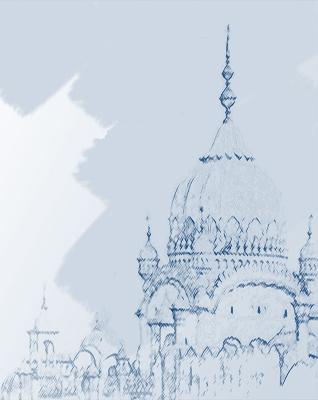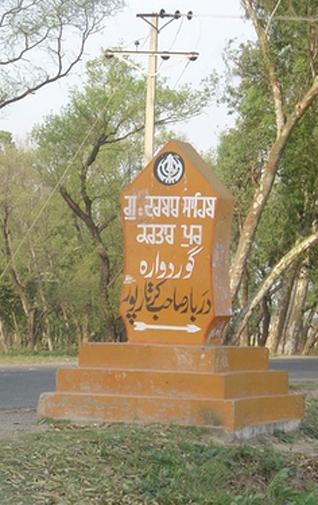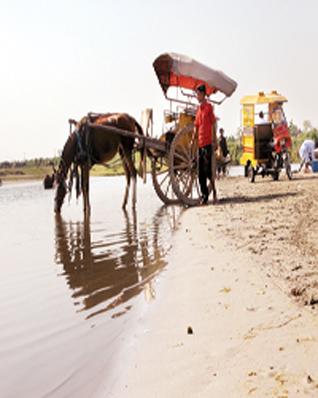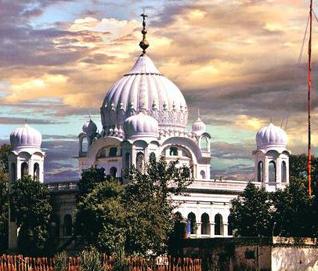Travel
Here Lived Guru Nanak
by SARWAT ALI
Kartarpur, one of the great historical sites in Sikhdom, is where Guru Nanak breathed his last.
Actually, he had founded the settlement earlier in his life, and then in his later years he came back to spend the remaining part of his life there. Once through with his endless journeys, he tilled the land - setting an example of humility and the dignity of working with one’s own hands, reuniting with the common folk, whose suffering and sorrows he was so acutely aware of. Here, he also instituted the langar where all could eat and drink, irrespective of faith, gender and caste.
The gurdwara is ideally located on a raised platform overlooking River Ravi, amidst a lush green valley that has the feel of the mountain air. This is the place where, today, the Ravi enters Pakistani territory, actually hitting the plains after rushing through the mountain slopes of the Himalayas. As one looks eastwards and northwards, the thickly forested environment forms a horizon beyond which lies the eastern half of Punjab which currently lies in India.
Like most gurdwaras, this too is multi-storied and as one ascends to the top landing, the panoramic view is very impressive - the plains are as if greeting the mountains. Apparently, it has been flooded quite a few times. One impressive dome constructed on the orders of Ranjit Singh was destroyed in one of the floods and the current structure, built under the patronage of the Maharaja Patiala about 80 years ago, is on a much raised platform so as to withstand the floodwaters of the Ravi, stands beside it majestically.
There are the remnants of a well that the Guru and his family drew water from and the guava orchard adjoining the gurdwara, which still bears fruit. It is said to have been cultivated by Guru Nanak himself.
Guru Nanak led a very active life. He travelled far and wide in spreading his universal message of truth and met many local sages and saints along the way. In those days when travelling was truly an ordeal, a gruelling test of one’s physical and mental endurance, Guru Nanak travelled to Mekkah, Baghdad, Sri Lanka, Kashi (Banares) and then up north to Mount Kailash and wondered in territories in what is now China and the Central Asian Republics. Also he traversed the length and breadth of the subcontinent's land mass.
Some questionable sources, mostly oral, also stress that he travelled to Europe and Africa but these have not been backed by written accounts. His travels, known as udaasiaa(n), hold a great deal of significance in understanding his life work.
Nanak was born in Talwandi Rai Bhoey which is now district Sheikhupura. The town is now known as Nankana Sahib in his sacred memory.
It is worthy of note that when the Sikh Scripture, the Guru Granth Sahib, was compiled by the later Gurus, it included the poetry of the Muslim Sufi saint, Baba Fareed of Ajodhan (now Pakpattan), the mystic who also widely acclaimed as the first major Punjabi poet known today.
As one goes from Narowal to Shakargarh and passes the decaying railway station of Jassar, after a few kilometres on the east one can see a white dome. There is a railway station that must have been built to facilitate the pilgrims in the past but now it is like the entire railway system - a decrepit sight.
From the main road, about a couple of kilometres away, is a narrow picturesque road that leads to the gurdwara situated all alone amidst a few unobtrusive buildings that house the keepers of the gurdwara and its maintenance staff.
Guru Nanak wanted to bring the faiths together and he founded a religion that was to do just that. In his death too it is said that the various factions and faiths started to quarrel as to what to do with his body - should he be buried or should he be cremated. As the story goes, when he saw that his time had come to move on, he asked for a wreath to be placed on his body. When the wreath was removed the next morning, to the amazement of the crowd, it was not the body of Guru Nanak but a heap of flowers that they found under it.
The devotees divided the heap flowers amongst themselves and disposed them off in accordance with their respective rites.
Though Sikhism soon grew to become a major world religion, yet it was Nanak who hade laid out its principles - and it was here in Kartarpur that he found time to do it all.
It is said that Bhai Mardana too died at Kartarpur and that his last rites were also observed there. The musician Bhai Mardana was a lifelong friend and devotee of Guru Nanak; he excelled in playing the rubab. The mystic poetry of Guru Nanak - considered one of the greatest poets in his own right - are said to have been set to music by Mardana.
It is said that, after his death, his son, Bhai Shahzaad, too was asked by Nanak to continue with the tradition of singing the religious texts. The descendents of Bhai Mardana were the minstrels of Sikhs in and outside the gurdwaras and were considered integral to the community.
The boundary of the Punjab on the Shakargarh side and also Jammu is amazingly beautiful but that has been lost to the ordinary citizens due to its inaccessibility, the fencing and heavy fortification because of the military tensions between India and Pakistan. But whenever there is an opportunity, it is a reminder of the beautiful landscape as the hills on the east and north saddle the vast uniform plains of the Punjab, a landscape very different from the rugged hills to the west.
Kartarpur was ravaged by
the Ravi many times over, so another settlement called Dera Nanak was also set
up across the river. It is difficult to tell since the river has kept
changing its course but some say that Kartarpur is the same as Dera Nanak,
while for others, it is another site across the river. And, sadly, in another country ... India!
[Courtesy: The News. Edited for sikhchic.com]
August 6, 2011
Conversation about this article
1: Pashaura Singh (Riverside, California, U.S.A.), August 06, 2011, 10:10 AM.
In 1999, I went to see the Gurdwara Darbar Sahib, Kartarpur, in Pakistan, at the instance of Dr. Gurcharan Singh Attariwala, Chairman of the Shrine Fellowship in Canada, who was mainly responsible for the renovation project at this Gurdwara with the help of the Pakistani authorities. During my visit, the renovation work was still going on. I wrote a brief report on the gurdwara as follows: The Gurdwara Darbar Sahib at Kartarpur is located on the western banks of the Ravi river near Jassar in the Narowal Tahsil in the Sialkot District of Pakistan. It commemorates the place where Guru Nanak lived the last eighteen years or so of his life and where he died on 22 September 1539. In fact, this was the place where Guru Nanak established the first dharamsala ("house of worship") after founding the village of Kartarpur ("Abode of the Creator") in the early 1520s. By this time his fame had spread far and wide, and in accordance with immemorial tradition, prospective disciples had gathered to learn from one whom they acknowledged as a preceptor and master. At Kartarpur, Guru Nanak gave practical expression to the ideals which matured during the period of his travels, and combined a life of disciplined devotion with worldly activities, set in the context of normal family life and a regular satsang ("congregation"). In fact, Guru Nanak's accomplishment in founding a new town with the help of his own followers speaks much of his organizational skills. His attractive personality drew an increasing number of people of different faiths to Kartarpur to join the newly emerging religious community which had begun to settle around him in this serene setting of rural Punjab. It is not surprising that the early Sikhs were frequently referred to as Kartaris, the people who belonged to the village of Kartarpur. The ideal person of the Kartarpur community was the gurmukh ("one oriented towards the Guru") who practiced the threefold discipline of naam-daan-ishnaan, that is, meditation on the divine Name, charity, and pure living. The first testimony about the Kartarpur period comes from Bhai Gurdas who had direct contact with Bhai Buddha, a resident of the Kartarpur community and a valuable link with the living voice of Guru Nanak. The specific reference from Bhai Gurdas (Vaar I:38) reads as follows: "Baba Nanak then proceeded to Kartarpur and put aside all the garments of renunciation. He clad himself in ordinary clothes, ascended his gaddi ("spiritual throne") and thus preached dharam to his people. He reversed the normal order by appointing his disciple Angad as Guru by bowing before him, shortly before his death. For his sons did not obey him, becoming instead perfidious rebels and deserters. Guru Nanak gave utterances to words of divine wisdom, bringing light and driving away darkness. He imparted understanding through discourses and discussions, the unstruck music of devotional ecstasy resounded endlessly. 'So Dar' and 'Aarti' were sung in the evening and, in the early morning, the Japji was recited. Those who followed him cast off the burden of the Atharva Veda and put their trust in the Guru's hymns." Indeed, this is the earliest surviving description of the Kartarpur community. Here Bhai Gurdas testifies that Baba Nanak settled down at Kartarpur after his wanderings in quest of Truth. He refers to the recitation of Japji in the ambrosial hours of early morning and the devotional singing of 'So Dar' and 'Aarti' in the evening. The community thus taking shape at Kartarpur had already acquired certain institutional features such as the sangat ("holy fellowship") where all felt that they belonged to one large spiritual fraternity; the dharamsala, the original form of the Sikh place of worship; and the establishment of the langar, the inter-dining convention which required people of all backgrounds to sit in status-free lines (pangat) to share a common meal. The institution of langar certainly struck at a major aspect of caste, thereby advancing the process of defining a distinctive Sikh identity. What appealed to Guru Nanak's followers was not only his wisdom but also the social concerns to which he gave clear and courageous expression. On the one hand, he rejected the old traditions of superstitions and magical spells based on the Athrava Veda, and on the other hand, he encouraged the use of his own compositions in liturgical prayers. From a historical point of view, therefore, the Gurdwara Darbar Sahib at Kartarpur enjoys a particular place of prominence in the Sikh tradition. This was the original centre of Sikhism where the first Sikh community came into being. Thus a great deal of sanctity is associated with it. In the beginning of the second decade of this century (1911-12), a Sehajdhari Sikh, Lala Shyam Das, built the present gurdwara and residential quarters. It formed an integral part of Sikh religious and social life and was managed and looked after by well-knit Sikh organizations. After the partition of Punjab, however, the management of this important Sikh monument was disrupted and therefore the responsibility for its maintenance and repairs fell on the Government of Pakistan. According to Khan Mohammad Waliullah Khan, the author of "Sikh Shrines in West Pakistan" (1962), annual repairs to the monument are carried out by the Rehabilitation Department and the Government of Pakistan has also appointed a caretaker to look after this important Sikh Shrine. More recently, there [was] a renewed interest in the restoration/ renovation of the gurdwara building to mark the tercentenary celebrations of the Khalsa. The Government of Pakistan has already sanctioned Rs. 750,000 for restoration purposes and the work is in full progress. However, there is an urgent need to address a serious problem of storm water drain which passes very close to the gurdwara and it is gradually eroding the pavement of the wall. There is a risk of serious damage to the gurdwara building unless a protective embankment is built. The cost of protective work is estimated to be around Rs. 800,000. The Chairman of Evacuee Trust is preparing a plan for this protective work but the financial outlay is heavy. Therefore, an urgent appeal (benti) is being made to the Sikh organizations around the world "to extend whatever help is possible" in this project and seek the blessings of the Guru.
2: Sangat Singh (Kuala Lumpur, Malaysia), August 06, 2011, 3:19 PM.
I do not know how to thank, first, sikhchic.com for taking us to Kartarpur, and then, Dr. Pashaura Singh ji for his thumbnail sketch. The example set by Guru Nanak is, I feel, a most defining moment in human history. It ultimately led to the gift of Bhai Vir Singh to the world. To explain this, I have to refer to his younger brother, Dr. Balbir Singh's learned expose, "Charan Hari Visthar". It starts with Diwan Kaura Mal and traces the full family history. The location was his fortress, "Garh Maharaja", in Multan, and for our purposes, starts with Baba Kahn Singh (not to be confused with Bhai Kahn Singh of Nabha). One morning Kahn Singh, then a lad of 14 years, absconded from his home and went missing for more than a dozen years. He spent his self-imposed exile in quest of his real self. He spent this time in company of sants and yogis who had also abandoned their families and had sought refuge in forests. After 14 years of wanderings, he finally reached Amritsar - a matted sadhu, by now relatively famous for his learning, and with an exceptional skill in native medicine. Somehow the news reached his mother in Multan that her missing son had been spotted in Amritsar. How she met her son is an uncanny story in itself. At that time a heated discussion among three sadhus was in progress. The weighty question was: "Is the creation of 'sansar' (the world) a result of 'gyan' or 'agyan'? Somehow, the conversation suddenly turned to their mothers. In particular, Kahn Singh mentioned that he had been dreaming about his mother lately. Just at that point, a fellow sant by the name of Ram Dyal Singh entered and announced that Khan Singh's mother had arrived. The lapse of years had created a wall between mother and son and it took a while for things to thaw. As they became comfortable with each other, the mother lovingly started to untangle Kahn Singh's matted hair, and asked her son: "Why did you run away from a life of comfort and luxury?" Kahn Singh answered that he had found life stifling at home and escaped to find the real purpose of life. He also explained that ancient scriptures subscribed to the notion that a child at birth came with 8 built-in 'bandhans' or bondages, and went on to list them. He explained that he had successfully conquered all of them, one by one, and he was now free of all worldly bondages. The simple but wise mother said: "That's wonderful, dear, but for now we still need a roof over our heads. It's time for you to get married!". Kahn Singh replied: "But Ma, this is impossible. I am a sadhu and am prohibited from returning to a life of a householder." Mother was quick to respond: "Son, you had mentioned having conquered the 8 bandhans. Now, it looks like you have a 9th bondage to free yourself from - the 'Saadhgari' bandhan, your enslavement to the life of a recluse!" At this point, her voice started to quiver: "Look son, this 9th bandhan was conquered by Guru Nanak. After four long 'udaasis' (world travels), he eventually returned to a life of a householder and settled in Kartarpur to set a most defining moment in the history of all religions, a life that has not been improved upon since!" History records that Baba Kahn Singh thereafter got married, and from this wedlock, Dr. Charan Singh was born, and then, in turn, was born Bhai Vir Singh, who has left us with a legacy of endless spiritual wealth. This was our Kartarpur.
3: B.S. Goraya (Amritsar, Punjab), August 06, 2011, 11:49 PM.
Thanks for publishing this beautiful article. [B.S.Goraya - Founder servant: Movement for Kartarpur Sahib Corridor].
4: Gurcharan Singh Attariwala (Nanaimo, British Columbia, Canada), August 07, 2011, 1:37 AM.
I was fortunate and blessed by the great Guru Nanak to visit Pakistan to attend the wedding of a friend's son (Dr Mehmud of Calgary) in 1992.During our stay in Lahore, Dr Mehmud's brother-in-law enquired if I had visited Darbar Sahib. I said yes, in Amritsar. He informed that there was a Darbar Sahib in Pakistan about which I was not aware of. He drove my wife and I to Kartarpur Sahib. The road signs and & Railway Station signs all read "Darbar Sahib, Kartarpur." We had to drive through a farmer's field to reach the building, which stood on banks of River Ravi. There was no road and, to my amazement, the building was deserted, there were no doors or windows, the beautiful ceilings were damaged from rain. Some of the domes were not existent. On a platform inside the main hall, there was a green drape, there was an old broken-down lamp and a dried rose flower on the floor. It was a sad scene to see this important historical buiding in this state. I was ashamed of our so called leaders for having paid no attention to such an important historical site. Upon my return to Canada, I communicated to my friend, Lt. Gen. Jahan Dad Khan, whom we had helped earlier with his Al Shifa Eye Hospital in Rawalpindi with funds and equipment. I told Gen. Khan that this site is as important to Sikhs as is Jerusalem to Muslims. He responded by saying that he has convinced the Pakistan Government to repair this building, provided the Sikh community too would contribute. A few of my friends got together (Jatinder Reyat, Master Dhaliwal, Uppinder Nanda, Mr. Khangura, Dr Teja Singh). We raised about $75,000. In 1997, Dr. Teja Singh and I went to Pakistan to see the progress. At that time, we gave a cheque of $20,000 to General Nasir (incharge of the historical shrines) in Lahore. For the first time after the Partition of Punjab, there was Prakash of Guru Granth Sahib and Shabad Kirtan in the repaired but still-unfinished gurdwara building. A jatha from Nankana Sahib had been brought in. With Guru's blessing, a gentleman - Sardar Jang Bahadar Singh from New Jersey - volunteered to go to Kartarpur Sahib and complete the project. He spent about three months and several hundred thousand dollars of his own funds to complete the building. This to me is Guru's Blessings that He completes His projects if undertaken honestly and sincerely by us. Since we had about $50,000 left from our collection, this was given to University Hospital Cardiac Center in Edmonton (Alberta, Canada) as part of our contribution for The Guru Nanak Healing Garden. This is another beautiful project for which we raised about $2 million. While Kartarpur Sahib project was going on, we raised the possibility of repairing the bridge between Kartarpur Sahib and Dera Baba Nanak across the River Ravi. Pakistani authorities were quite willing, provided the Indian Government also agreed. We leave this project to our present youth to pursue.
5: Teja Singh (Brampton, Ontario, Canada), August 08, 2011, 10:57 PM.
As we presented the $20,00 cheque to Lt Gen Nasir, I requested him before leaving to extend his personal care in completing the renovation of Kartarpur Sahib. His reply: "Neither I will be doing it, nor you. Guru Nanak will do it." He asked for a written report on the present condition of the five historic gurdwaras, including Kartarpur, that were to be visited by us. This was prepared and handed over as we were departing. He promised that all the points raised by us would receive full attention of the Government of Pakistan. When reminded on our arrival in Canada, he replied that everything mentioned in our report would be completed by the time we visit Pakistan again. The attention of the Prime Minister of India was drawn to Kartarpur Sahib by me in a letter dated 8 December,2000: "Guru Nanak Shrine Fellowship is a Canadian charitable organization recently established to secure safeguards and access to the historic shrines left in Pakistan ... According to a news item in The Tribune of Chandigarh (Nov. 10), the President of Pakistan has agreed to sanction a small corridor for pilgrims to visit the Kartarpur shrine across the River Ravi during low-flow period. We regard this as a positive step for providing convenient access to the historic site where Guru Nanak spent the final years of his life ... Kartarpur is a highly symbolic place where Guru Nanak's body was claimed equally by the Hindus and the Muslims, who regarded him their own Guru and Pir ... The Government of Pakistan has restored and renovated the shrine at the request of [Sikh] communities of the western countries by spending nearly 50 million rupees this year ... The proposed corridor, with adequate security measures on either side, is a practical solution for providing direct access for the devotees and admirers of Guru Nanak, when visiting India. The present land route through the Wagah border is too circuitous and long (Wagah-Lahore-Narowal-Kartarpur). Your own historical trip to Lahore is a reminder and call to all of us to tackle disputes or problems peacefully. Prime Minister, we need and seek your support and leadership to make this mission a practical reality. The short corridor access, connected by a 'Bridge of Peace' during the non-Monsoon season, will be a great step and gesture from both Governments to preserve Kartarpur as a world heritage site." A written plea on similar lines was made to General Parvez Musharraf in my letter dated 14 December 2000. Repeated requests have been made to both sides since then by Sikh organizations and others to open up the 3 km passage from Dera Baba Nanak in India to Kartarpur Sahib in Pakistan. The world waits for the politicians to make a move ...
6: Gurcharanjit Singh Attariwala (Nanaimo, British Columbia, Canada), August 10, 2011, 4:29 PM.
For the sake of historical correctness, I wish to modify my previous write up re Kartarpur Sahib Gurdwara dates.The Canada Trust cheque of $20,000 was given to Gen. Javed Nasir on the name of Evacuee Trust Property Board, Govt. Of Pakistan on Nov 18, 1999. The first inauguration of the Gurdwara was also held in the month of November 1999, which was attended by Ch. Riaz Aziz, M.L.A., who talked of the past glory of this gurdwara with fruit orchards, etc. Mr Uppinder Nanda was especially sent to Pakistan to arrange electrification and proper fixtures, which cost us approximately $5,000.






